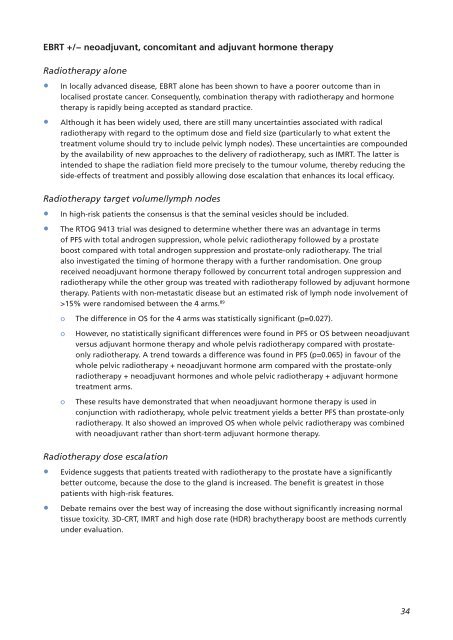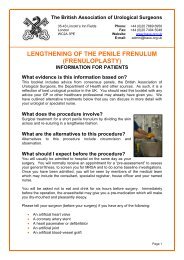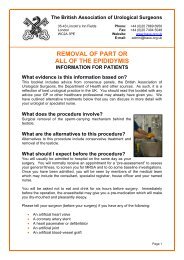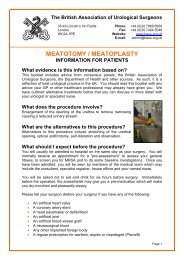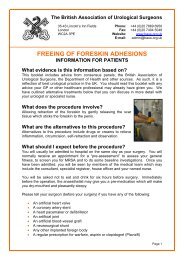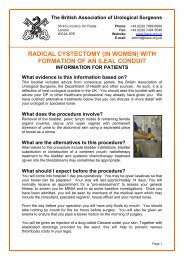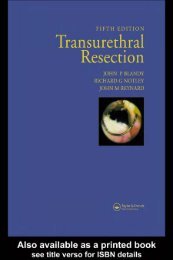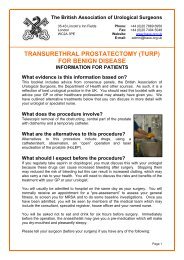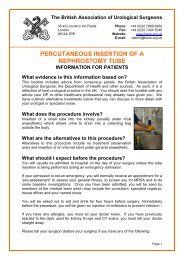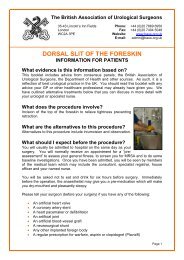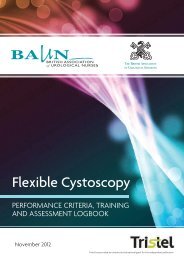MDT (multi-disciplinary team) guidance for managing prostate cancer
MDT (multi-disciplinary team) guidance for managing prostate cancer
MDT (multi-disciplinary team) guidance for managing prostate cancer
You also want an ePaper? Increase the reach of your titles
YUMPU automatically turns print PDFs into web optimized ePapers that Google loves.
EBRT +/− neoadjuvant, concomitant and adjuvant hormone therapy<br />
Radiotherapy alone<br />
• In locally advanced disease, EBRT alone has been shown to have a poorer outcome than in<br />
localised <strong>prostate</strong> <strong>cancer</strong>. Consequently, combination therapy with radiotherapy and hormone<br />
therapy is rapidly being accepted as standard practice.<br />
• Although it has been widely used, there are still many uncertainties associated with radical<br />
radiotherapy with regard to the optimum dose and field size (particularly to what extent the<br />
treatment volume should try to include pelvic lymph nodes). These uncertainties are compounded<br />
by the availability of new approaches to the delivery of radiotherapy, such as IMRT. The latter is<br />
intended to shape the radiation field more precisely to the tumour volume, thereby reducing the<br />
side-effects of treatment and possibly allowing dose escalation that enhances its local efficacy.<br />
Radiotherapy target volume/lymph nodes<br />
• In high-risk patients the consensus is that the seminal vesicles should be included.<br />
• The RTOG 9413 trial was designed to determine whether there was an advantage in terms<br />
of PFS with total androgen suppression, whole pelvic radiotherapy followed by a <strong>prostate</strong><br />
boost compared with total androgen suppression and <strong>prostate</strong>-only radiotherapy. The trial<br />
also investigated the timing of hormone therapy with a further randomisation. One group<br />
received neoadjuvant hormone therapy followed by concurrent total androgen suppression and<br />
radiotherapy while the other group was treated with radiotherapy followed by adjuvant hormone<br />
therapy. Patients with non-metastatic disease but an estimated risk of lymph node involvement of<br />
>15% were randomised between the 4 arms. 89<br />
o The difference in OS <strong>for</strong> the 4 arms was statistically significant (p=0.027).<br />
o However, no statistically significant differences were found in PFS or OS between neoadjuvant<br />
versus adjuvant hormone therapy and whole pelvis radiotherapy compared with <strong>prostate</strong>only<br />
radiotherapy. A trend towards a difference was found in PFS (p=0.065) in favour of the<br />
whole pelvic radiotherapy + neoadjuvant hormone arm compared with the <strong>prostate</strong>-only<br />
radiotherapy + neoadjuvant hormones and whole pelvic radiotherapy + adjuvant hormone<br />
treatment arms.<br />
o These results have demonstrated that when neoadjuvant hormone therapy is used in<br />
conjunction with radiotherapy, whole pelvic treatment yields a better PFS than <strong>prostate</strong>-only<br />
radiotherapy. It also showed an improved OS when whole pelvic radiotherapy was combined<br />
with neoadjuvant rather than short-term adjuvant hormone therapy.<br />
Radiotherapy dose escalation<br />
• Evidence suggests that patients treated with radiotherapy to the <strong>prostate</strong> have a significantly<br />
better outcome, because the dose to the gland is increased. The benefit is greatest in those<br />
patients with high-risk features.<br />
• Debate remains over the best way of increasing the dose without significantly increasing normal<br />
tissue toxicity. 3D-CRT, IMRT and high dose rate (HDR) brachytherapy boost are methods currently<br />
under evaluation.<br />
34


